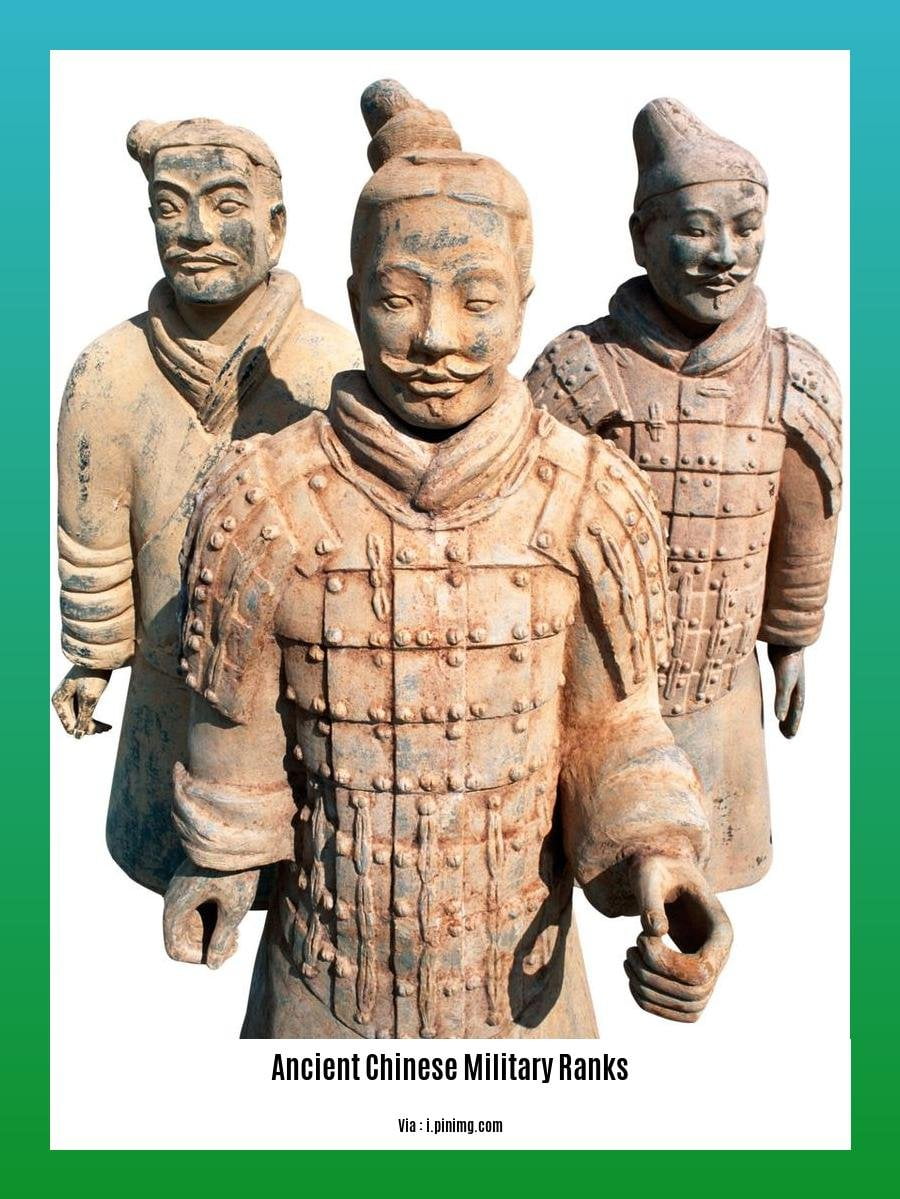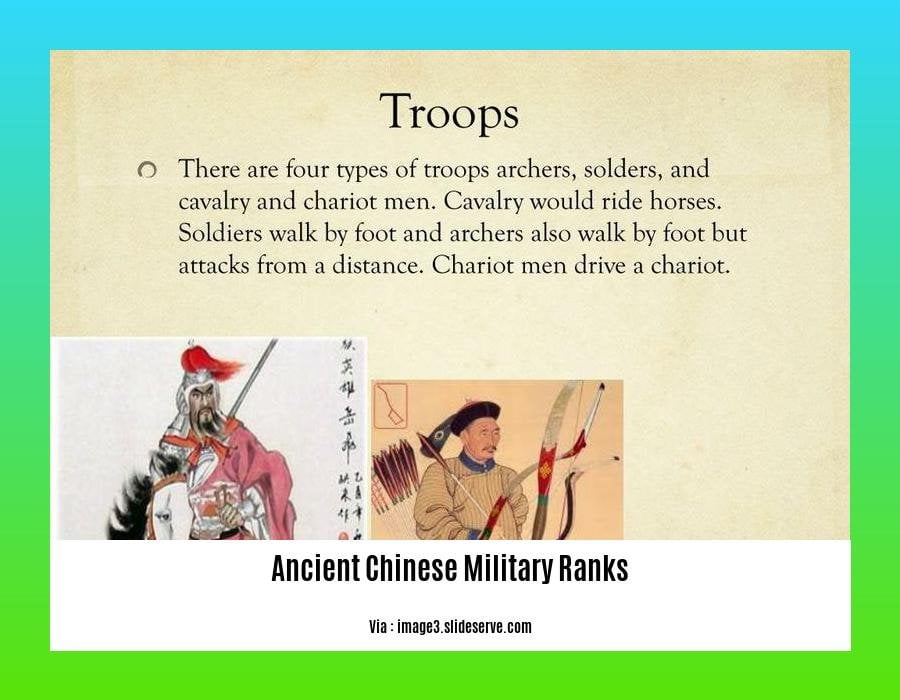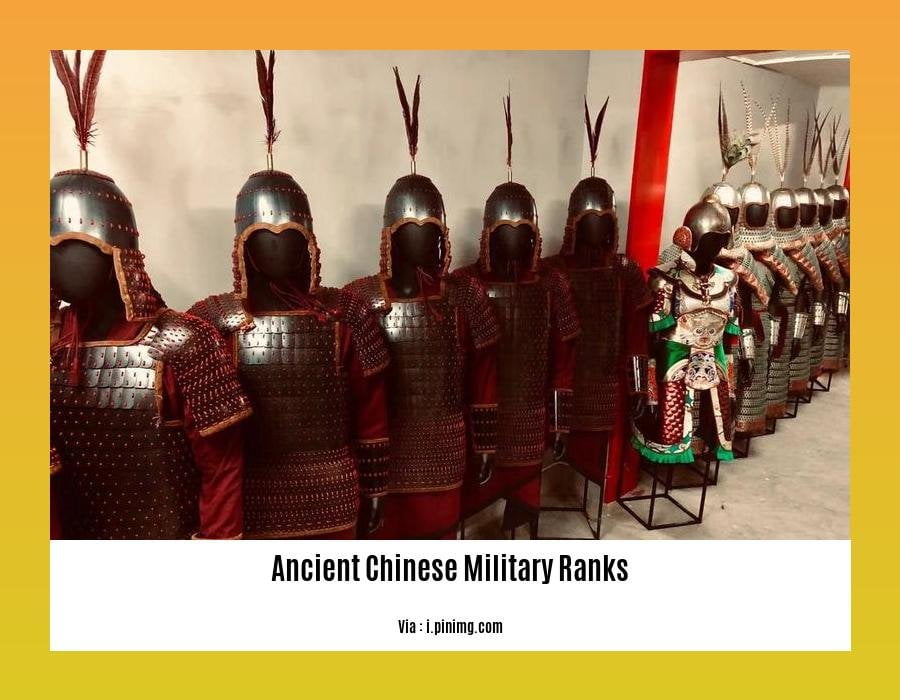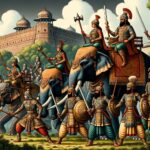Welcome to the fascinating world of ancient Chinese military ranks! Imagine yourself transported back in time to a land of fierce warriors and epic battles. Join us as we unearth the secrets of the complex hierarchy that governed these ancient armies, shaping their strategies and destinies. From the humble origins of tribal warriors to the intricate systems that guided legendary battles, we’ll unravel the evolution of these ranks through ancient scrolls and archaeological wonders. Get ready to discover how these military machines paved the way for the empires and civilizations that shaped the course of history.

Ancient Chinese Military Ranks: A Tale of Discipline and Organization
Picture this: ancient China, a time of mighty warriors and fierce battles. At the core of this military powerhouse was a well-oiled machine—a strict hierarchy of military ranks that kept everything running like clockwork.
The Ladder of Command
Just like the rungs of a ladder, the ancient Chinese military had different levels of ranks, each with its own set of duties and responsibilities. At the very top sat the General (Jiangjun), the big boss who called the shots.
Right under the General was the Second in Command, also known as Wei. This person was like the General’s backup, filling in when the General couldn’t be around.
After that came a bunch of other important ranks:
- Lieutenant General (TongJun): The General’s assistants who helped keep things organized.
- Colonel (Jinzhou): Commanders of large units, like generals with their own little armies.
- Lieutenant Colonel (JunFu): Second-in-command of the Colonel’s unit.
- Captain (Duizhu): Leaders of smaller groups, like the captains of a ship or the heads of a marching squad.
The Backbone of the Force: Subordinate Ranks
But the military wasn’t just about the big shots. The real backbone was made up of lower-ranking folks like sergeants and corporals. These guys were the ones who made sure the everyday operations went smoothly, kept the soldiers in line, and made sure orders were carried out.
The Chain That Kept Things in Order
All these ranks worked together like a well-oiled chain, passing orders down from the top to the bottom. It was like a superhighway of commands, making sure everyone knew what to do. This chain was the key to keeping the military disciplined, united, and ready to face any challenge.
More Than Just Ranks: A Reflection of Society
The military ranks were more than just a way to organize the army. They were also a reflection of Chinese society. Ranks were often linked to a person’s social status and importance, making the military a prestigious and respected institution.
Learn more about the fascinating ancient coins of India that have captivated historians and collectors alike. Dive into the world of ancient fishing methods and discover the ingenious techniques used by our ancestors to catch their prey. Explore the intricate system of ancient Chinese military ranks and discover their history and significance.

Who Commanded the Ancient Chinese Military? Exploring the Ranks of Leadership
Buckle up, history enthusiasts! We’re venturing into the mesmerizing realm of ancient Chinese military ranks, where we’ll uncover the movers and shakers who commanded the nation’s formidable armies.
Unveiling the Leadership Pyramid
Picture this: an army on the battlefield, each soldier diligently performing their duties. Who’s in charge of this well-oiled machine? It’s none other than the valiant leaders who stood at the helm of ancient China’s military ranks.
Generals: The Commanders-in-Chief
At the peak of the military hierarchy, we find the Generals, renowned for their strategic brilliance and battlefield prowess. These exceptional individuals guided countless campaigns, orchestrating victories and ensuring the safety of the realm.
Second in Commands: The General’s Sidekicks
Right behind the Generals, we have the Second in Commands, aka Wei. These skilled warriors served as the Generals’ trusted assistants, providing invaluable support in planning and executing military operations.
Unit Commanders: Leading the Frontlines
Leading smaller military units were the Unit Commanders. These valiant individuals kept their troops in line on the battlefield, ensuring that each soldier knew their role and executed it with precision.
Rank and Privilege: A Hierarchy to Rule Them All
In ancient China, military ranks were a big deal. They not only designated a soldier’s authority but also granted them prestige and social status. The higher the rank, the more respect and glory they commanded.
How It All Worked
The ancient Chinese military was a complex organism, and ranks played a pivotal role in its smooth functioning. Like a well-oiled machine, orders flowed seamlessly from the top to the bottom, ensuring that the entire army operated in perfect harmony.
Conclusion
The ranks of the ancient Chinese military were a testament to the nation’s organizational prowess and strategic brilliance. From the commanding Generals to the loyal Second in Commands, each rank played a crucial role in shaping the destiny of China’s armies.
From General to Sergeant: The Hierarchy of Ancient Chinese Military Ranks Explained
Imagine the ancient Chinese army as a towering pyramid, with the mighty General perched at the peak. Ranks cascaded down like a series of steps, each step leading to a different role and responsibility.
At the pinnacle stood the General (Jiangjun), the supreme commander of the entire army. He mapped out battle strategies, directed troops, and ultimately bore the fate of the nation on his shoulders.
Trailing the General was his trusted Second in Command (Wei). Like a loyal deputy, the Wei shared the burden of decision-making and stepped into the General’s shoes when needed.
Next in line came the Lieutenant General (TongJun), a commander of specific army units. He organized and led divisions into battle, ensuring the smooth execution of the General’s plans.
A step down, the Colonel (Jinzhou) headed regiments, the building blocks of the army. His job was to train and prepare his troops for the rigors of combat.
Battalions found themselves under the command of Lieutenant Colonels (JunFu), who ensured discipline and coordinated operations within their ranks.
Captains (Duizhu) led companies, the sharp-edged swords of the army. They motivated their soldiers, maintained morale, and guided them through fierce battles.
At the base of the pyramid, Sergeants and Corporals formed the backbone of the ancient Chinese army. They enforced order, instilled discipline, and kept the ranks from crumbling under pressure.
Each rank had its own unique set of responsibilities and privileges. Like a symphony, they worked together, each cog playing its part in the smooth functioning of the military machine.
Moreover, military ranks held immense social significance in ancient China. Generals were revered as heroes, and even ordinary soldiers enjoyed a higher status than civilians. The army was a beacon of prestige, attracting young men eager to make a name for themselves and serve their country with honor.
In summary, the ancient Chinese military was a rigidly structured organization where ranks mirrored the wider social hierarchy. From the General to the Sergeant, each rank carried specific duties and privileges, contributing to the army’s effectiveness and social standing.
Unveiling the Ancient Chinese Military: A Comprehensive Guide to Ranks and Responsibilities
Step into the Ranks of Ancient China’s Warriors
Imagine yourself in the heart of ancient China, where the military was a force to be reckoned with. Just like in our modern armies, the Chinese had their own system of ranks that determined who was in charge, what their duties were, and how much respect they deserved.
A Hierarchy of Honor
The Chinese military’s rank structure mirrored the strict social order of their society. It was a pyramid, with the most important people at the top. At the very peak was the Taiwei, like the generalissimo of the whole army. Below him were generals, field marshals, colonels, lieutenant colonels, and captains—each with their own responsibilities and authority.
The Official Ranks
The Chinese ranks weren’t just names; they were numbers from one to nine, with even more levels within each rank (just like our privates, sergeants, and so on). Each rank had its own salary, uniform, and privileges. So, being a higher-ranked officer meant not only more power but also better perks.
Society’s Ladder
In a society where respect and order were everything, military ranks mattered a lot. The higher your rank, the more people had to bow and scrape to you. It was like a badge of honor that showed everyone how important you were.
A Well-Oiled Machine
A military is only as good as its organization. The Chinese army’s rank structure made sure that everyone knew who was in charge, who they reported to, and what they were supposed to do. It was like a giant jigsaw puzzle, with each piece fitting together perfectly.
Victories and Legacy
Thanks to its well-defined ranks, the Chinese military was able to conquer vast territories, defend their borders, and make history. Their rigid hierarchy ensured that orders were followed, armies moved quickly, and battles were won.
Remember:
- The Chinese had a nine-rank system, with upper and lower levels.
- The Taiwei was the supreme commander.
- Generals, colonels, and captains had different responsibilities and authority.
- Ranks influenced salary, uniform, and social status.
- The rank structure ensured order, discipline, and effectiveness.
FAQ
Q1: What was the highest military rank in ancient China?
A1: The highest-ranking military officer in ancient China was the General or Jiangjun.
Q2: What was the title of the second-in-command in the ancient Chinese military?
A2: The Second in Command assisted the Unit Commander and took charge in their absence.
Q3: How were military ranks determined in ancient China?
A3: Military ranks in ancient China were determined by the official rank system with 9 numbered ranks, subdivided into upper and lower levels.
Q4: What was the role of subordinate ranks in the ancient Chinese military?
A4: Subordinate ranks, such as sergeants and corporals, played a crucial role in the day-to-day operations of the military.
Q5: How did the ancient Chinese military rank system reflect the social structure of the time?
A5: The ancient Chinese military ranks reflected the rigid social structure of imperial China, with ranks and positions holding great importance and denoting authority, privileges, and order of precedence.
- 1 Liter to Fluid Ounces: Easy Conversion Guide - April 9, 2025
- Unlock what is the seventh month: A Cross-Cultural Calendar Guide - April 9, 2025
- Discover White Fruits: Ultimate Guide to Taste & Nutrition - April 8, 2025
















